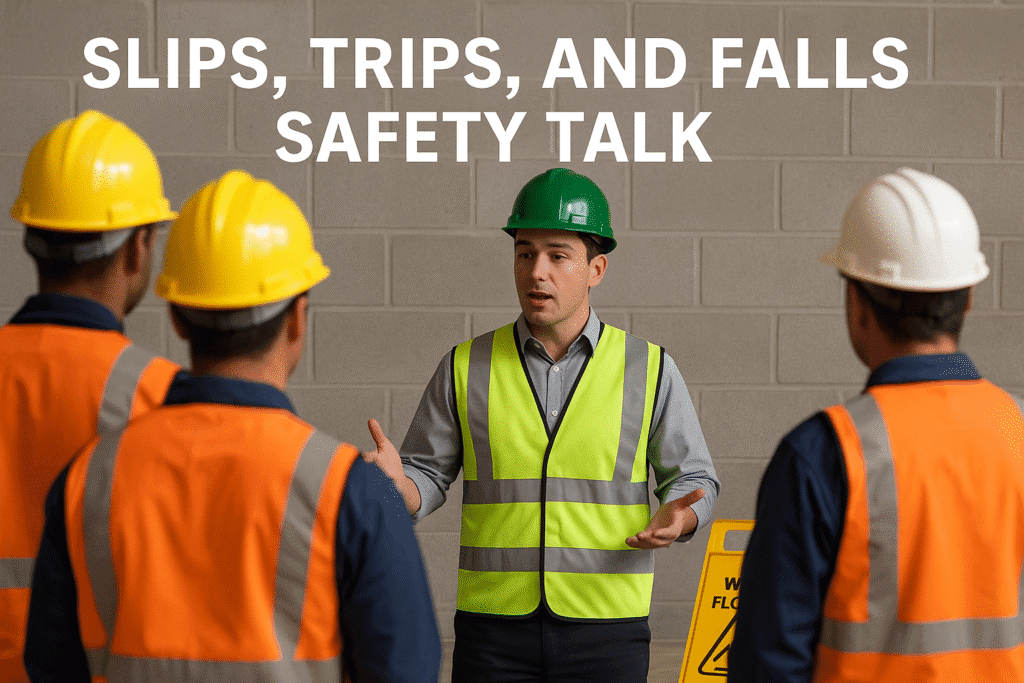
Slips, Trips, and Falls Safety Talk
Role: Safety Officer
Duration: ~10 minutes
Audience: All site employees and contractors
Format: Toolbox Talk / Daily Briefing
1. Opening & Greeting
“Good morning team,
Before we begin our tasks today, I want to talk about something that may seem minor but is actually one of the most common causes of workplace injuries — Slips, Trips, and Falls.
These accidents don’t just happen on construction sites — they occur in offices, workshops, warehouses, and even parking areas. And the consequences can range from minor bruises to serious fractures, spinal injuries, or even fatalities.”
2. Purpose of the Talk
“By the end of this safety talk, you’ll understand:
- The causes of slips, trips, and falls
- How to recognize potential hazards
- Simple steps to prevent these incidents
- Your role in maintaining a safe work environment”
3. Why This Matters
“Let’s look at the facts:
- Slips, trips, and falls account for over one-third of all workplace injuries.
- They result in lost workdays, increased insurance costs, and serious injuries.
- These incidents are 100% preventable with awareness and proper housekeeping.
So even if you’ve been working for years without an incident — stay alert. It only takes one careless step to change your life.”
4. Common Causes of Slips, Trips, and Falls
Let’s break it down:
A. Slips – Occur when there’s not enough traction between your foot and the floor.
Causes include:
- Wet or oily surfaces
- Spills not cleaned up
- Smooth or polished floors
- Ice or mud during bad weather
- Improper footwear
B. Trips – Happen when your foot hits an object, and you lose your balance.
Causes include:
- Unsecured cables and cords
- Tools and materials left on walkways
- Uneven surfaces
- Open drawers, loose mats, or curled-up carpet edges
C. Falls – Often result from slips or trips.
They can be:
- Same-level falls (most common)
- Falls from heights (ladders, stairs, scaffolds)
- Falls into holes or open pits
5. Preventive Measures
Let’s go over some practical steps to prevent slips, trips, and falls:
Housekeeping:
- Clean up spills immediately — or report them
- Keep walkways, stairs, and work areas clear
- Store tools and materials properly
- Close drawers and cabinets when not in use
Work Environment:
- Ensure adequate lighting — especially in stairways or basements
- Place “Wet Floor” signs after cleaning
- Use non-slip mats or coatings in slippery areas
- Secure cables and hoses with cable covers or tape
Ladders & Stairs:
- Use handrails at all times
- Don’t rush — take one step at a time
- Never carry items that block your view
- Inspect ladders before use and never use damaged ladders
Footwear:
- Wear slip-resistant, appropriate shoes for your work area
- Replace shoes with worn-out soles
- Use toe guards or covers if required
6. Unsafe Behaviors to Avoid
“Let’s be honest — many of these incidents are caused by rushing, multitasking, or ignoring hazards.
Avoid:
- Walking while texting or not paying attention
- Jumping from vehicles or platforms
- Using makeshift steps like boxes or drums
- Walking through unauthorized or cluttered areas
- Ignoring small spills — they can lead to big injuries”
7. What to Do If an Incident Occurs
“If you or someone else experiences a slip, trip, or fall:
- Stop work immediately and report to a supervisor
- Seek medical attention if injured — don’t ‘shake it off’
- Record the incident — even if it’s minor
- Secure the area to prevent others from getting hurt
- Investigate the root cause — fix it to prevent recurrence”
8. Your Responsibility
“Everyone plays a role in preventing these incidents:
- Be aware of your surroundings
- Speak up when you see a hazard
- Take responsibility for cleaning and clearing your area
- Follow procedures and wear the right PPE
Remember, safety isn’t just the safety officer’s job — it’s a team effort.”
9. Final Reminders
“To summarize today’s key points:
- Slips are caused by wet, greasy, or slick surfaces
- Trips occur due to obstacles or uneven surfaces
- Falls can result from both — and lead to serious injuries
- Practice good housekeeping, wear the right shoes, and stay alert
- If you see something unsafe — fix it or report it”
10. Open Discussion
“Any questions, concerns, or observations from the site regarding slip, trip, and fall hazards?
Has anyone seen a near-miss situation or wants to share a lesson learned?”
[Encourage worker participation.]
11. Conclusion
“Thanks for your time and attention.
Let’s make a commitment today — to keep our work areas clean, watch our steps, and look out for each other.
A safe step is a smart step. Let’s keep each other safe.”
Compressed Gas Cylinder Safety Talk
100 Safety Topics for Daily Toolbox Talk PDF
130+ Safety Talks and Toolbox Talk Meeting Topics
5 Minute Safety Talk on Work at Height
5 Minute Safety Talk on Personal Protective Equipment (PPE)
Safety life of worker